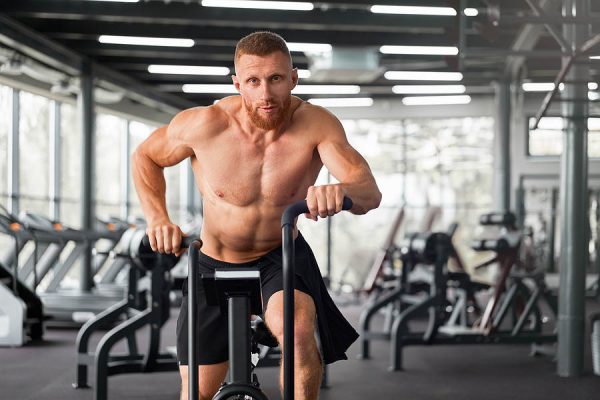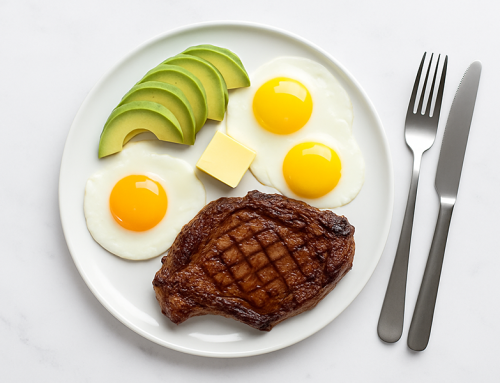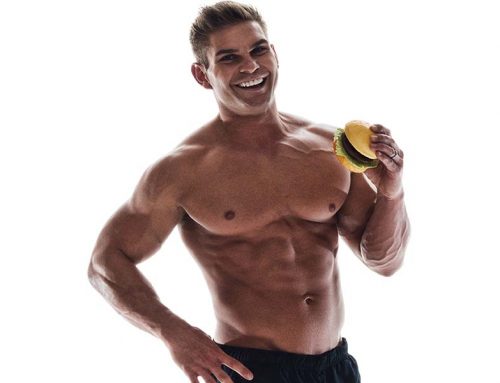What is the best HIIT workout for fat loss? That’s not easy to say because there are so many different types of HIIT workouts and many of them are effective. And while many HIIT workouts been researched, many studies don’t track actual fat loss. Rather, they measured health and cardiovascular benefits. However, there are some HIIT workouts that are not only proven more effective for fat loss, but also, they’re more practical.

One problem with some types of HIIT is that they call for so much intensity – literally all-out sprints – that they’re not even possible for everyone to complete. They’re also potentially unsafe for older or overweight individuals. When the intensity is too high, the workouts are just not practical.
Many of the previous studies on HIIT used all-out intervals on a specialized cycle ergometer, pedaling against a high level of resistance. This type of training takes a high level of commitment and motivation and can result in feelings of severe discomfort and even nausea.
One of my colleagues mentioned in our Burn the Fat Inner Circle Forums that he remembers exercise physiology class in college where they did all out cycle ergometer interval sprint testing and nearly everyone either puked or passed out.
The Tabata protocol for example, is a brief but brutal 4 minute HIIT workout often spoken of by trainers and trainees alike with both appreciation and dread. It’s no walk in the park. Tabata is also quite overrated for fat loss because no matter how high the intensity level, you can only burn so much fat in 4 minutes. Fat loss is also a function of workout duration, not just intensity alone.
The truth is, some HIIT protocols which have been tested in the lab to produce big improvements in cardiovascular function and conditioning in a short period of time, may not be practical or safe, especially for beginners, obese or older adults.
In a recent study out of McMaster University, a HIIT protocol that was more practical and attainable for the general population was tested to see how the results would compare to the more “brutal” very short, but extremely intense types of HIIT.
Here’s what the new HIIT protocol looked like:
Study duration: 2 weeks
Frequency: 3 sessions per week (mon, wed, fri)
Work intervals: 60 seconds @ constant load
Intensity Work intervals: “high intensity cycling at a workload that corresponded to the peak power achieved at the end of the ramp VO2peak test (355 +/- 10W)”
Recovery intervals: 75 seconds
Intensity Recovery Intervals: Low intensity cycling at 30W”
Rounds: 8-12 intervals
Progression: 8 intervals 1st two workouts, 10 intervals second two workouts, 12 intervals last 2 workouts.
Warm up: 3 min:
Duration of work intervals: 8-12 minutes
Total time spent: 21-29 minutes.
Results: In just 2 weeks, there were significant improvements in functional exercise performance and skeletal muscle adaptations (mitochondrial biogenesis). Subjects did not report any dizziness, nausea, light headedness that is often reported with all-out intervals.
They concluded that HIIT does not have to be all-out to produce significant fitness improvements and yet the total weekly time investment could remain under 1 hour.
On a personal note, I really like this kind of interval training: 60 second work intervals repeated 8-12 times. Here’s why:
Body composition was not measured in this study, but if you consider the duration of the entire workout (up to 29 minutes) and the amount of accumulated high intensity work (up to 12 minutes), it appears fairly evident that this style of interval training could give you serious body comp improvements in addition to all the cardiovascular conditioning improvements.
That’s another problem with super-brief and super intense HIIT programs: The cardio and heart benefits are amazing, but you can only burn so many calories per minute, no matter how intensely you work. To call a 4-minute workout a “good fat burner” in the absolute sense is ridiculous.
Somewhere in between long duration slow/moderate steady state cardio and super short super-intense HIIT lies a sweet spot for fat-burning benefits… a place where intensity X duration yield an optimal total calorie expenditure at a reasonable time investment. Perhaps this 20-30 minute HIIT workout is it?
If you’ve read any of my previous posts on cardio, you’ll know that I’m not against steady state cardio, walking or even light recreational exercise and miscellaneous activity as part of a fat loss program. All activity counts towards your total daily energy expenditure, and in fact, the little things often add up during the day more than you would imagine (just look up N.E.A.T. and see what you find).
But for your formal “cardio training” sessions, if you’re going to use traditional cardio modes (stationary cycle, etc) and if your goal includes fat burning and if your time is limited, this type of HIIT is a great choice and you can now say it is research proven…
Not to mention… the excuse, “I don’t have enough time” has been officially busted!
Train hard and expect success,
Tom Venuto,
Author of Burn the Fat, Feed the Muscle
Author of The BFFM Guide to Flexible Meal Planning For Fat Loss
Already have the Burn the Fat, Feed The Muscle books? Awesome! The next step is to join the Burn the Fat Inner Circle, our members-only online community and support site: www.BurnTheFatInnerCircle.com
Reference:
A practical model of low-volume high-intensity interval training induces mitochondrial biogenesis in human skeletal muscle: potential mechanisms. Little JP, Safdar A, Wilkin GP, Tarnopolsky MA, Gibala MJ. J Physiol. 588(Pt 6):1011-22. McMaster University, Hamilton, Ontario, Canada [Pub Med]

Tom Venuto is a natural bodybuilding and fat loss expert. He is also a recipe creator specializing in fat-burning, muscle-building cooking. Tom is a former competitive bodybuilder and today works as a full-time fitness coach, writer, blogger, and author. In his spare time, he is an avid outdoor enthusiast and backpacker. His book, Burn The Fat, Feed The Muscle is an international bestseller, first as an ebook and now as a hardcover and audiobook. The Body Fat Solution, Tom’s book about emotional eating and long-term weight maintenance, was an Oprah Magazine and Men’s Fitness Magazine pick. Tom is also the founder of Burn The Fat Inner Circle – a fitness support community with over 52,000 members worldwide since 2006. Click here for membership details






How intense were these workouts?
Hi Tom,I used to do a boatload of steady state high intensity cardio, or “H.I.S.S”, as you affectionately call it. I got great results because I REALLY pushed myself. I would wear a heart rate monitor and would average in the low to mid 170s, and sometimes even low 180s. Obviously I was burning a plethora of calories, but eventually I incurred overuse injuries (plantar fasciitis).Most of my cardio at that time was restricted to running on the treadmill, and sometimes outdoors. I was doing the same thing over and over, and my waist was shrinking, seemingly by the day, but it became onerous. I started to dread my workouts, even though they were effective.Once I began incorporating H.I.I.T. into my fitness repertoire, my results were magnified, and most importantly, I was enjoying myself in the process. I would alternate work intervals of 60 second sprints on the treadmill, at between 10 and 11 mph, and recovery intervals of walking at 4 mph.It was arduous, to say the least, but it taxed my central nervous system like no other. I got the idea from Rusty Moore, who advocates 20-30 minutes of H.I.I.T., followed by 20-30 minutes of steady state, if one is so inclined.That is what I’m doing nowadays. Monday, Wednesday and Friday, I will do H.I.I.T, for 30 minutes, followed by a bout of steady state for the same period of time. Tuesday, Thursday, Saturday and Sunday, I do 45-60 minutes of H.I.S.S.I’ve also included mountain biking, and jump roping, to my arsenal. Between utilizing the two modalities of cardio, coupled with new activities, my results have been outstanding, and my cardio routine has been sustainable.I know if I keep going, my midsection will eventually resemble thaf of the great fitness model, Greg Plitt. His body is absolute perfection IMO, although yours isn’t too shabby either LOL.Thanks for all you do! Your website is a veritable treasure trove of useful information.
Andrew heres what the paper said on intensity:”60 second effort of high intensity cycling at a workload that corresponded to the peak power achieved at the end of the ramp VO2peak test (355 +/_ 10W. These intervals were interspersed by 75 seconds of cycling at a low intensity (30W) for recovery.”Thats pushing very hard for a minute (but not 100%), then backing off to a very slow pace for 75 seconds X 8-12 repeats.
Hi Tom,Thanks for always keeping us up to date on the latest info.You are indeed a treasure to those of us that continue to need education.You’re like a “Fat-Burning” Encyclopedia!Keep up the great research…we appreciate it!!
Well, this is good news for me. I am a 61 year old female who has been working out at some level since I started swimming competitively at 13. You name it, most likely I’ve done it — or some variation of it. For about two years now I have been doing something similar on the ergometer (which I love) but 30/60 or 60/120 – 2/3x week. The high intensity bursts are fun and tough. However, what I have learned over the years is change is good. It keeps the body challenged, the mind engaged,fights boredom and reduces the chance of injury. My current new 3 month core program is kettlebell centered — but I also do some kickboxing, smoke sessions (Iron and burn with the kbs), spin, a 10,000 steady row once a week, swim and yoga or pilates. Stick to the core principles and mix it up every once in awhile. And good nutrition. Stay focused while working and enjoy it.
Great post!To answer the intensity question: elite athletes can maintain this power output (100% of VO2 peak) for about 7:00. Fit adults would for about 4:00.I look forward to seeing this modality (100% VO2 peak) compared with all out intervals in the same study (all out intervals are usually 250% VO2 peak). This should tell us whether pushing ourselves so much is worth it in the end.Good job Tom.CJ
This recent research is definitely great news and has been something that Angie and I have sworn by for the past 7 years. As much as the main stream ‘experts’ were trying to tell us that it had to be all out during the working phase we found that activities such as skipping, jumping jacks, and knee up worked just as well. We also combined them with higher intensity exercises such as burpees, jump squats, and sprints.I absolutely love variety. We can get a load of variety from H.I.I.T. as well as long duration cardio. For me, it’s all about fun and pushing myself to become better while enjoying and appreciating my surroundings.I sure appreciate all the work that you do in an effort to provide us with the most honest and up to date fat loss research out there. I know for certain that it’s no easy task.Thanks a million Tom!
This sounds like a pretty cool workout. I am still working on getting down my weight. I’ve never been ‘thin’ a day in my life. First of all as a kid I learned all the WRONG eating ‘skills’. Plus I have a condition which makes it take longer for my muscles to heal and I’m always anemic. I have gotten bruises from doing just about any kind of exercise…weights, rowing, running etc.I used to just give up because I got tired of being tired and sore all the time. But then I learned a few things. I decided that before anything else I had to do whatever to get myself consistently to the gym. The only time I don’t go is if I have a bleeding issue. Then I do a brisk walk instead or yoga at home.I have been consistently going to the gym for 6 months. I’m at the point I know I will feel better after I leave the gym. I love the point I break out in a sweat…and love even more when its dripping off me! I’m at 170lbs at 5’7 med/large build. Maybe it sounds bad but at my worst I was 240lb and miserable.and SOOO….this seems really cool because I find cardio kind of tough because it’s hard for me to stay focused! this type of training will also keep my mind more focused on exercising. But being the geek at the gym I am….can anyone explain more clearly how you do this. I understand constant load…but what are you really doing in recovery intervals? The things I like to do the most are rowing and swimming (freestyle and breaststroke). Any advice and info would be greatly appreciated!!
Do not let numbers the numbers on the scale weigh your good spirits (: Personally the only thing my heart desires to *H.I.T.T* is a *Punching Bag* (: in regards to the recovery explanation…maybe you can ask *TOM* (:!!!! -fmhty and *REMEMBER* the value of being a *GEEK AT THE GYM* far outweighs the value of being *THE TEMPTRESS AT THE GYM* xoxoxoGESUNDHEITxoxoxo
As I’ve progressed through my workouts, I notice that it takes me longer to get to a cardio heartrate, and if I stop for some reason, my HR is dropping off faster than it used to. I just wonder what I’d have to do to make HIIT effective for me.
Fantastic article Tom. The first thing that comes to mind is the added benefit to a specific population that this is appropriate for, and also to support the continued point you make about “there is no time” excuse, which is of course nonsense.As as personal trainer, I know the benefits of HIIT, and also steady state for lower intensity exercise for those that can only manage this type of training. I have many clients who need something in the “middle” and this is it!Love the evidence based research too mate, keep it coming.Regards, ClaytonAdelaide Personal Trainers
Love the concept and effectiveness of HITT but for me it isn’t an option. I wanted to add to that past injuries etc are also a reason why HITT would not work for all people. I know I am one more injury away from a complete ankle reconstruction and am not supposed to run unless its life threatening.I think it is important in our industry to put the truth out there that there is no set standard for cardio – it is what is good for the person and as long as they do something for cardio then that is a working option. There is just too much out there pushing that HITT is the only option for fat loss and it is very frustrating to have so many “frustrated” people who can’t or do not want to do HITT – it shouldn’t make them feel that they aren’t putting their best efforts forward.Great presentation of the real facts Tom.
Bear with me there is a question coming. . .I am using various workouts which I think of as high intensity interval weight training to burn fat pretty much in lieu of cardio. (e.g. 5 squats, 20 plank rows, 20 lunges, rest 60 sec repeat 6x/ or 50 sec of hang cleans 10 sec rest, 50 sec burpees, 50sec squat press up, rest 60 sec repeat 5x)I increase the weight or tempo, or decrease the rest interval to try to increase the “intensity” as much as possible. Aside from just liking to feel like an animal, the reason i try to get the intensity high as I can stand is that I believe more intense workouts burn more calories because of the phenomenon of Excess Post Exercise Oxygen Consumption (EPOC) (more than because of the extra calories you burn during the exercise itself.) I got this notion from an exercise book, which didn’t cite any study.Is this a myth or have you heard of this too? Does focusing on it make sense as a calorie burning strategy? Just curious if you know or have an opinion. Thanks for all the excellent information.
Eric, the high intensity training DOES increase post exercise calorie expenditure (EPOC), but not as much as many people think. The idea that you burn more calories after the workout is totally false, which is why we need to focus primarily on burning sufficient calories DURING the workout if fat loss is the primary goal. The “afterburn” effect is a nice and potentially significant added bonus, but total calorie expenditure should be the primary goalThis is an intersting study on the subject of EPOC:Effects of exercise intensity and duration on the excesspost-exercise oxygen consumption, Laforgia et al, Journal of Sports Sciences 24:12, 1247-1264. 2006:Quote:“the earlier research optimism regarding an important role for the EPOC in weight loss is generally unfounded.”http://www.ncbi.nlm.nih.gov/pubmed/17101527
Thanks for posting- this makes a lot of sense: a happy median that’s easier to stick to and less chance of stress injuries. I’ll let you know in two weeks how it works…
This is great to hear as I moving into the older age bracket :)I had a heart bypass about ten years ago which does not limit me in any way but at the same time I am mindful of what my body tells me.My HITT exercise days are jogging or walking at a fast steady pace up a very steep grassy hill and then walking down. It is a steep hill, one that almost makes you have to run down. I just keep on going, up, down , up , down I will do that for about 20 min and then do some fast walking on a flat surface or some jogging/walking or slow walking if I am tired.It isn’t scientific but it works for me and I am encouraged my your post as I always thought I needed to get to the puke stage to have done a good job.Thanks Tom.
Tom,While part of the benefit of this type of work is time efficiency, if time is available, would it be beneficial to tack on 15-20 minutes of low intensity work (lower end for longer interval sessions and higher end for shorter interval sessions)? In a way this would just tack onto the cool down, but it seems like it would be maxing out the benefit of the low intensity work.Of course added NEAT at any time will likely yield essentially the same overall results, but for fat burning, post interval training would seem like a very good time to tack on a small it of LISS work.
As a sports/fitness coach in New Zealand working with rugby and touch rugby players I can tell you that the guys I coach absolutely dread doing Tabatas. We have another high intensity exercise we use called Hennie Mullers which is just as brutal.And therein lies a major disadvantage with high intensity stuff – its brutal nature can lead to mental fatigue. And that’s why I intersperse ultra-short intervals with some longer intervals and also circuit training.The sort of protocol described in the research is one way to add some variety, maintain fitness levels, and be less intense on the mind and body.Thanks for pointing it out Tom.CheersBen
Hi Tom,Thanks for the post. This is exactly what I’ve been doing since last summer! Except that my recovery intervals are only 60 seconds. After 10 intervals I continue until I’ve reached a total time of 35 minutes. I do this on my old Nordictrack ski machine. I find it very effective as well as more challenging & less boring than plain old LISS. It also saves a bit of time. Glad to know scientific research says I’m doing something right. LOLDebbie :)
Hey Tom!Thanks for the research update. I love interval training and mixing things up and it is VERY nice to know there is research coming out that states ‘all out’ bursts are not necessary for acheiving desired results. Appreciate you “Keeping It Real” and sharing!Amy
I’m encouraged by this research, but noticed in the paper that the subjects were young (21), fit, men. I’m wondering how the benefits will translate to us older, more out of shape folks.I’m definitely planning on trying it though. I’ll set up my own case study of one!
Hello Tom,I want to incorporate this kind of HIIT on my Tuesdays, Thrusdays and Saturdays mornings before I leave to work.I already do light cardio on empty stomach on Mondays, Wednesdays and Fridays. Recumbent Stationary Bike.My question:Can I do this HIIT in the morning on empty stomach ?If not, could you please provide some food intake advice before it ?Thank you!
I knew every little about HIIT but in May I started sprinting; i was a sprinter and gymnast in my youth and I absolutely loved both and wondered whether I could still do it at 44. At first, my legs were weak as a kitten’s, but after about 4-6 weeks I could feel the muscles in my legs and butt growing ! I manage 2-3 times a week doing what I call a sprint/walk for about 30 mins. I sprint hard and fast until failure and then walk until I’ve got my breath back, then sprint etc. I wanted to give myself a bit more of a curvy shape and its worked; I am lucky that I am an easy gainer though! My energy levels is way up and I just feel much stronger all round. I can still do cartwheels too!I also believe HIIT of this type is much the better option because the wear and tear on the joints is minimal compared to the usual long jogging sessions favoured by so many and which I hate. I sprint around fields and the uneven surface also makes the muscles more responsive as well as it being kinder on the knees.This may sound odd but I think why this works is because it mimics our hunter-gather ancestral life of bursts of intense activity; energy wouldve been conserved rather than squandered on long sessions of keep fit exercise.
I’ve been performing HIIT as my main form of cardio for close to 10 years now, and it’s one of the primary reasons (along with weight training) that I’m in the best shape of my life at 54 years old. My preferred form of HIIT is running sprints. For example, I sprint 50 yards then walk 50 yards, and then continue to alternate these work and recovery intervals for about 15 minutes.
Many people ask me what I do to stay in such good shape, and when I talk about my sprinting routine I can tell that they have no interest in pushing themselves that hard. I’m glad to learn that research shows that someone who has no interest in the type of HIIT that I do can perform a less intense form of HIIT and still get plenty of health benefits from it.
(: YOU KNOW WHAT?(:* IF YOU’RE GOING TO GET ON ANY TYPE OF FITNESS MACHINE…YOU MIGHT AS WELL MAKE THE BEST OF YOUR TIME AND HAVE FUN! (:
Tom I got BFFM years ago, and your teaching on cardio intervals is ingrained in me..its the only way I do it now…great stuff!!!
Thanks David. this HIIT cardio template works great for fat loss doesnt it? (and you dont even have to puke, LOL) :-)
Yo Tom,
HIIT!!!!!!!!! IT.
Yes, I love HIIT. Given that it’s been about 15 years since I wrote the first popular article on HIIT, In Muscle Media, “HIIT IT” was the title, I think.
I originally presented it, as the science first was born, in 20 min. with 60-60… I evolved it to a more gradual and peaking model in Strength for LIFE.
And yes, cardio benefits, muscle preserving, performance enhancing. Yes, yes…
And, as I’ve evolved to become a cycling enthusiast, riding thousands of miles a summer (about to go down stairs and ride the trainer now) I’ve come to know another interesting truth about the human body.
It came to me in the understanding of “Base miles.” You see, as a recovering bodybuilder (LOL) I like to go out and hit the canyons to ride like I’m torturing an enemy… so when I came to get the pre-season performance, when i learned from a true cycling coach, I was informed that I was to DO BASE MILES.
WTF are Base Miles?
Well, that’s riding flat, easy, steady… it’s low intensity… it’s hours of just putting in miles… just miles.
WHY? Because you’re teaching the body to prefer or at least “want” to burn fat as a fuel source.
Aha! Shazamm.. if you’re going to ride for 8 hours, if you’re going to do 100-150 miles a day, you damned well better be able to burn fat for fuel. RIght..
So, it gets me thinking… HIIT teaches your body to prefer sugars, carbs, energy… which is great… because there is an afterburn… etc.
But slow steady says and “trains” the body to burn fat… and I think there’s something in that… and something we might open one or both eyes to.
Yeah, so… BOTH may be the answer.
To Your Full Strength,
Shawn
Shawn great insights (and btw, I remember that article…. ahhh those were the good old days…) anyway, yes BOTH indeed may be the answer on MANY levels. kind of like cardio periodization isnt it? It was funny seeing HIIT appear on the scene followed by the pendulum swing of attacks on the “worthlessness” of steady state cardio – remember that? it was polarized and dogmatic viewpoints. now just in last few years its coming back to center and we’re seeing people write about the value in both.